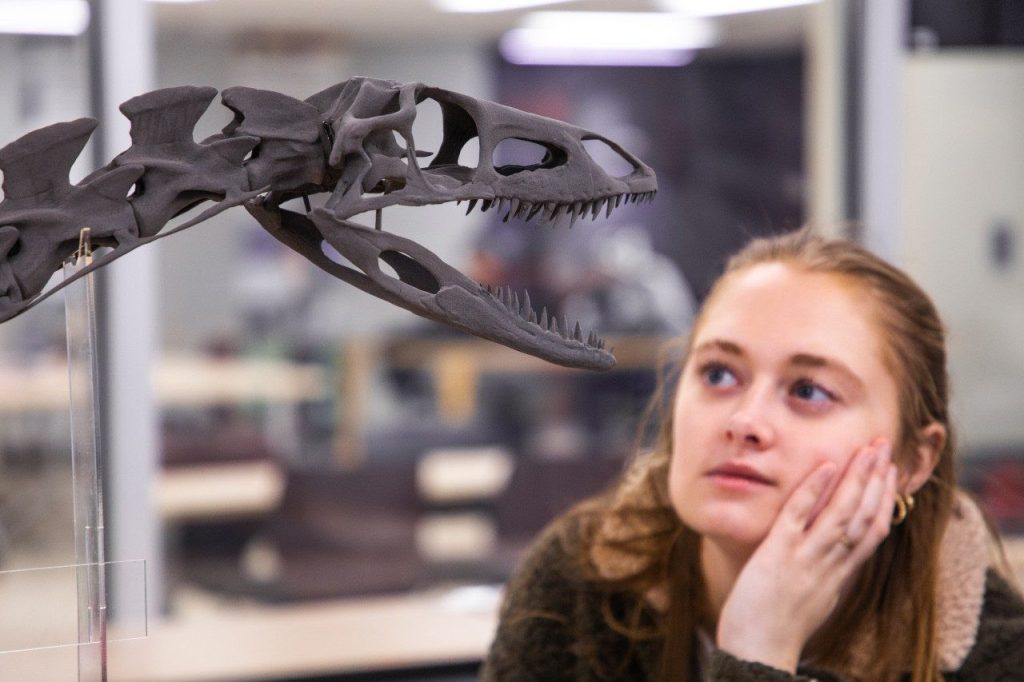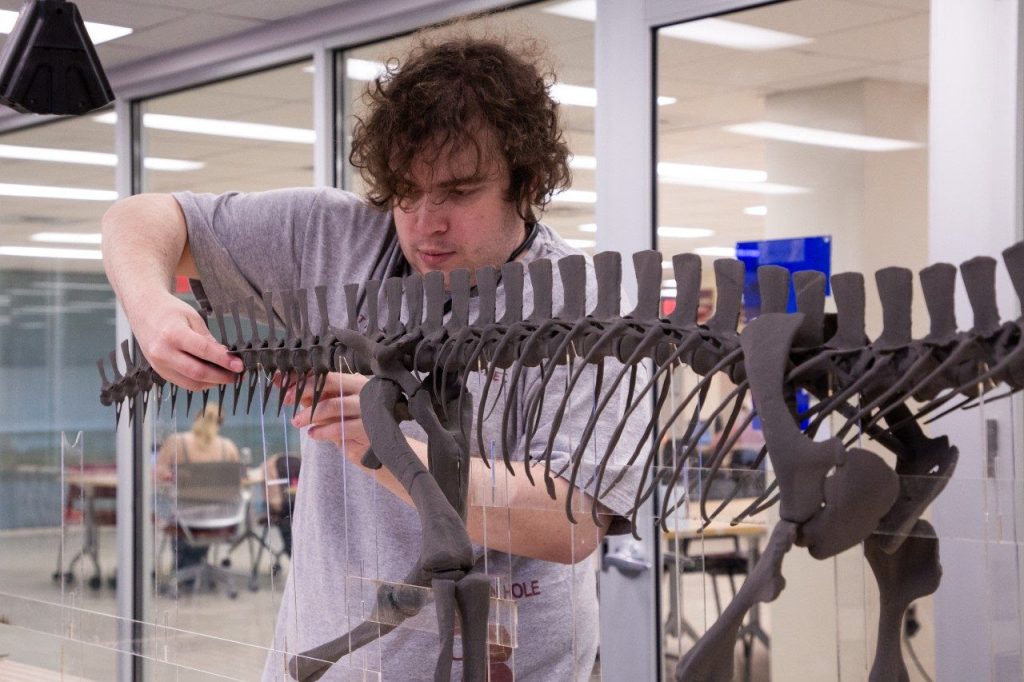

BLACKSBURG – Skeletons thought lost to history are being recreated one fragile fossil at a time in University Libraries’ Prototyping Studio.
3D scanners and printers are constructing strikingly realistic replicas of the extinct Teleocrater rhadinus using ancient fossils from more than 240 million years ago. Funded through an Institute for Creativity, Arts, and Technology grant, University Libraries is showing how technology can illuminate the past and bring long-extinct organisms face to face with the present.
The team, led by Sterling Nesbitt and Michelle Stocker of the Department of Geosciences, had about 80 percent of the skeleton from the collections of five individuals from two fossil sites in Tanzania to use to replicate the bones in the studio.
The first incomplete specimen was found in the 1930s and housed in the Natural History Museum in London. Nesbitt, paleontologist and professor, was still missing pieces, so he was part of a team that trekked to Tanzania to the area where the first specimen was found and unearthed more bones from a rich fossil deposit.
All of the original bones except for the ones in London are temporarily on loan to Virginia Tech for study and will be returned to Tanzania in perpetuity.
At nine feet long and two feet tall at the hips, the Teleocrater was first named in 2017 and is a dinosaur cousin that is closer to birds and dinosaurs than crocodiles. “Teleocrater is the perfect specimen for this project as it gives us a first look at how dinosaurs inherit their features,” said Nesbitt. “The smaller size also makes it easier to print.”
“By harnessing the power of 3D printing rather than relying on traditional casting methods, we can bring extinct species back to life for a fraction of the cost and weight and make it accessible to the world via digital files,” said Max Ofsa, manager of the Prototyping and 3D Scanning Studios. “A museum-grade exhibit of cast fossils of this size would likely get into the hundreds of thousands of dollars in cost to develop and fabricate whereas the printed fossils are only in the hundreds.”
“Using an iterative process while developing the final printed model has allowed us to remove the need for most of the external support structures and instead design a model that interlocks and self supports the fossil structure,” said Ofsa.
Prototyping Studio Specialist Rob Jackson used the skeleton’s 3D render to prepare it for printing.
“This was done by converting individual fossil pieces provided into larger segments with additional supports and interlockings,” said Jackson. “This way, parts can be manufactured in large easy-to-assemble segments instead of a weaker and tedious piecemeal process.”
Nesbitt did the modeling of the skull and much of the body.
“I worked meticulously using relatives of the Teleocrater and other reptiles to fill in the gaps where pieces were missing and then created a digital sculpture,” said Nesbitt.
The first skeleton is going to the Natural History Museum in Dar es Salaam, the capital of Tanzania. The second replica will be on display in the Virginia Tech Museum of Geosciences.
These skeletons are accompanied by an innovative app built by students and staff in the Applied Research in Immersive Experiences and Simulations program in University Libraries and Jonathan Bradley, assistant director of studios innovative technologies, using technologies that animate the creature and provide insightful information, serving as a centerpiece of an immersive educational experience. Wandering among the towering skeletal constructs on museum floors, visitors will be transported back millions of years to when these majestic creatures roamed the earth. The app will feature a translation in Swahili in honor of where the original bones were born.
“It’s about bringing content to people who aren’t exposed to it,” said Nesbitt. “You can walk into a museum and see a skeleton, it’s neat and a part of the history of our planet, but you only have a small panel to describe the details. This project brings technology to tell the stories of what extinct animals represent – its history, biology, how it was collected, how it was made and printed, the entire process it went through. The app plus the skeleton brings it all together. These are gateways into our past and our present.”
In addition to Nesbitt, Stocker, Ofsa and Bradley project team members include Thomas Tucker, Scott Fralin, Phyllis Newbill and Todd Ogle.
“This project has united a massive group of great thinkers across campus,” said Nesbitt. “The library, scientists, engineers, the School of Visual Arts — the list goes on. It’s a huge collaborative project at many different levels, unraveling the mysteries of the dinosaur age.”
Ann Brown for Virginia Tech




